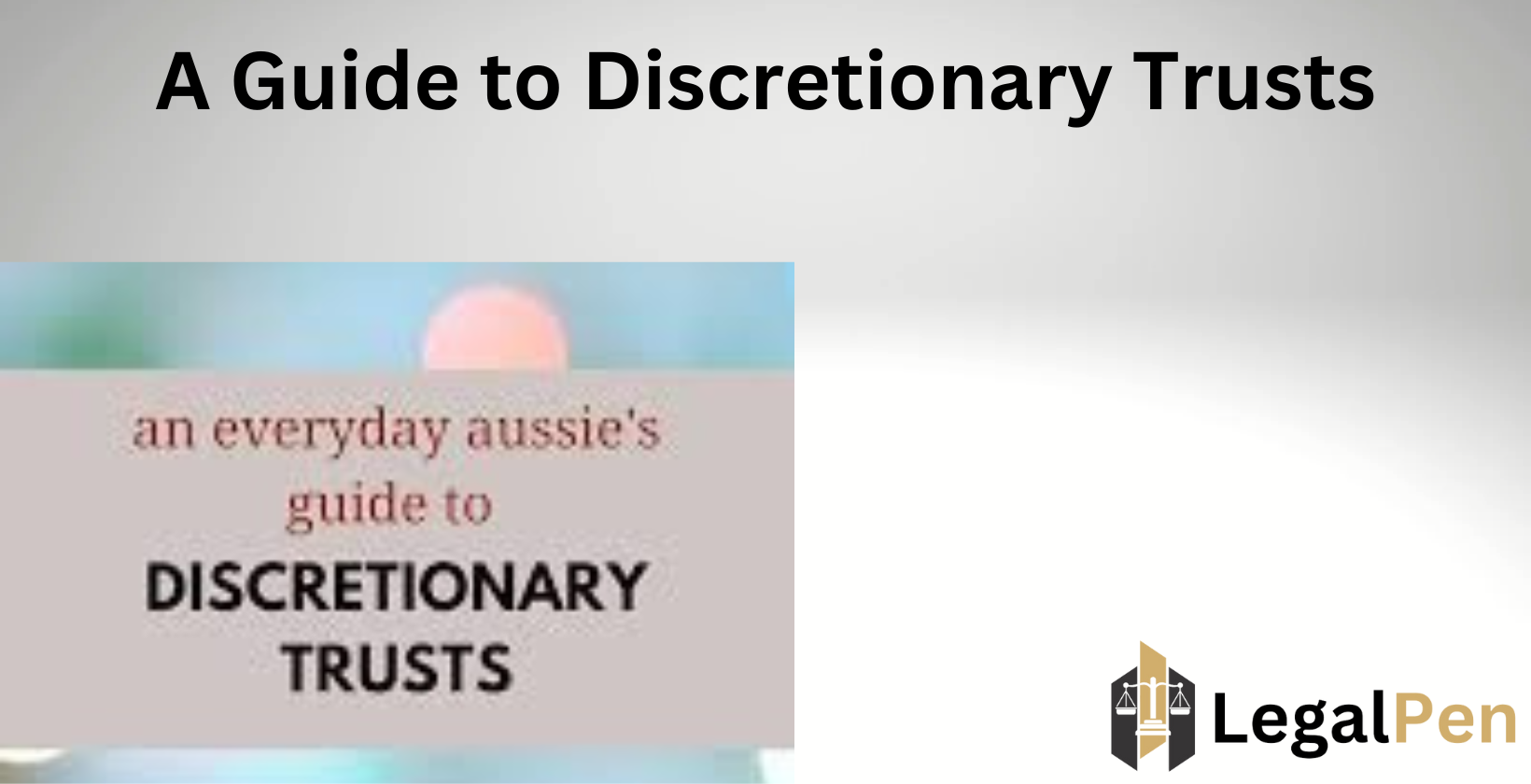A discretionary trust provides a flexible way to manage and distribute assets while protecting wealth for future generations. This guide covers its structure, benefits, legal considerations, and how it compares to other trust types.
What is a Discretionary Trust?
A discretionary trust is a legal arrangement where a settlor transfers assets to trustees, who manage and distribute them to beneficiaries based on their discretion. Beneficiaries do not have fixed entitlements, and trustees decide how, when, and to whom distributions are made, following the terms set in the trust deed. This structure provides flexibility, asset protection, and potential tax advantages.
How Does a Discretionary Trust Work?
A discretionary trust works by transferring assets from a settlor to trustees, who manage and distribute them according to the trust deed. Trustees have full discretion over how, when, and to whom distributions are made among the beneficiaries. Beneficiaries do not have automatic rights to the trust assets. The trust can hold various assets, including cash, property, and investments, and trustees make decisions based on the needs and circumstances of beneficiaries.
What are the Benefits of a Discretionary Trust?
The benefits of a discretionary trust include:
- Asset Protection – Assets held in the trust are safeguarded from creditors, lawsuits, bankruptcy claims, and financial mismanagement by beneficiaries. Since beneficiaries do not have direct ownership of the assets, they remain protected from external claims.
- Tax Planning – Trustees can distribute income to beneficiaries in a way that minimizes overall tax liability. By allocating funds to beneficiaries in lower tax brackets, the trust can reduce the tax burden on distributions. In some jurisdictions, discretionary trusts offer inheritance tax and capital gains tax advantages.
- Flexibility in Distribution – Trustees have full discretion over how and when distributions are made, allowing them to assess each beneficiary’s financial situation, health, and needs before making payments. This ensures that funds are allocated based on current circumstances rather than fixed rules.
- Control Over Wealth – The settlor can specify conditions and guidelines in the trust deed, ensuring assets are managed and distributed according to their long-term intentions. This is particularly useful for preserving family wealth across generations.
- Protection Against Beneficiary Risks – Since beneficiaries do not have direct control over trust assets, the funds remain protected from issues such as reckless spending, divorce settlements, or addiction-related financial misuse. The trustees ensure that distributions align with the beneficiary’s best interests.
How Do You Set Up a Discretionary Trust?
Setting up a discretionary trust involves several key steps to ensure legal compliance and effective asset management. The process requires careful planning, selection of trustees, and proper documentation to protect assets and control distributions. Below are the essential steps to establish a discretionary trust:
- Define the Purpose – Establish the reason for creating the trust, such as protecting family wealth, minimizing tax liability, or ensuring controlled asset distribution. The purpose will determine the trust’s structure and key provisions.
- Choose the Settlor – The settlor is the person who creates the trust by transferring assets into it. They decide the trust’s terms and objectives but typically relinquish control over the assets once they are placed in the trust.
- Select Trustees – Trustees are responsible for managing the trust and making discretionary decisions on distributions. Choosing reliable and financially competent trustees is crucial. A mix of professional and family trustees may ensure both expertise and personal understanding of beneficiaries’ needs.
- Identify Beneficiaries – Beneficiaries are the individuals or groups who may receive benefits from the trust. They do not have automatic rights to the trust assets, as distributions are made at the trustees’ discretion. The trust deed can define a broad or specific group of beneficiaries, such as children, grandchildren, or charities.
- Draft a Trust Deed – This is the legal document that governs the trust. It outlines trustee powers, distribution guidelines, asset management rules, and any specific instructions from the settlor. It should be prepared by a qualified legal professional to ensure compliance with applicable laws.
- Transfer Assets to the Trust – The settlor moves assets such as cash, property, investments, or business interests into the trust. These assets will be legally owned by the trust and managed by the trustees for the benefit of the beneficiaries.
- Register the Trust (if required) – Depending on jurisdiction, the trust may need to be registered with tax authorities or regulatory bodies. Registration ensures compliance with reporting and taxation requirements.
- Set Up Ongoing Administration – Trustees must maintain proper records, file tax returns, and make informed decisions about distributions. Regular trustee meetings and financial reviews help ensure the trust operates effectively and serves its intended purpose.
What is the Role of Trustees in Discretionary Trusts?
The role of trustees in discretionary trusts is to manage the trust’s assets and make decisions on distributions to beneficiaries based on the trust deed. Their responsibilities include:
- Managing Trust Assets – Trustees oversee investments, properties, and other assets to ensure their growth and preservation.
- Exercising Discretion – Trustees decide how, when, and to whom distributions are made, considering beneficiaries’ financial needs and circumstances.
- Acting in Beneficiaries’ Best Interests – Trustees must prioritize beneficiaries’ well-being while following the terms set by the settlor.
- Complying with Legal and Tax Obligations – Trustees ensure the trust complies with tax laws, file necessary returns, and adhere to regulatory requirements.
- Maintaining Records and Reporting – Trustees keep accurate records of financial transactions, distributions, and trust decisions to ensure transparency and accountability.
- Holding Regular Trustee Meetings – Trustees meet periodically to review trust performance, assess beneficiaries’ needs, and make informed distribution decisions.
How Do Discretionary Trusts Fit into Retirement Planning?
Discretionary trusts fit into retirement planning by providing asset protection, tax efficiency, and controlled wealth distribution. They help retirees manage their financial legacy while ensuring long-term financial security for beneficiaries.
- Protecting Retirement Savings – Assets placed in a discretionary trust are safeguarded from creditors, lawsuits, and potential financial mismanagement.
- Ensuring Controlled Distributions – Trustees can distribute funds gradually, preventing beneficiaries from misusing inherited wealth and ensuring long-term financial stability.
- Minimizing Tax Liabilities – Trusts allow income splitting among beneficiaries, reducing the overall tax burden by distributing funds to those in lower tax brackets.
- Preserving Eligibility for Government Benefits – Beneficiaries receiving government assistance can continue to qualify, as trust assets do not count as personal wealth.
- Facilitating Estate Planning – A discretionary trust helps retirees pass on wealth without immediate tax consequences while maintaining control over how assets are used.
- Providing for Dependents – Retirees can ensure ongoing financial support for children, disabled family members, or other dependents through structured trust distributions.
Legal and Tax Considerations for Discretionary Trusts
Discretionary trusts are subject to legal and tax regulations that affect their structure, management, and distributions. Understanding these considerations helps ensure compliance and tax efficiency.
- Trust Deed Requirements – The trust deed must be legally valid, clearly outlining the powers of trustees, the rights of beneficiaries, and asset distribution rules.
- Trustee Duties and Liabilities – Trustees have a fiduciary duty to act in the best interests of beneficiaries and comply with legal obligations, including proper asset management and reporting.
- Taxation of Trust Income – Trust income may be taxed at the trust level or distributed to beneficiaries, who then pay personal income tax based on their tax brackets.
- Capital Gains Tax (CGT) Implications – Selling trust assets may trigger CGT, depending on jurisdiction. Some trusts qualify for exemptions or rollover relief under specific conditions.
- Inheritance and Estate Tax Considerations – Discretionary trusts can help reduce estate taxes by keeping assets outside a person’s direct estate, but tax rules vary by country.Compliance and Reporting Obligations – Trusts may need to be registered with tax authorities and submit annual tax returns, financial statements, and records of distributions.
- Beneficiary Tax Treatment – Beneficiaries may be liable for taxes on distributions received, depending on whether the payments are classified as income or capital.
- Anti-Avoidance Rules – Some jurisdictions impose anti-avoidance rules to prevent tax evasion, limiting the benefits of discretionary trusts in certain cases.
Understanding Beneficiary Rights in Discretionary Trusts
Beneficiaries of a discretionary trust do not have fixed entitlements but hold potential rights that depend on trustee decisions. Their rights include:
- Right to Be Considered for Distributions – Beneficiaries are eligible to receive trust distributions, but they do not have an automatic claim. Trustees must assess each beneficiary’s circumstances before making a distribution.
- Right to Fair and Impartial Treatment – Trustees are obligated to act in good faith and consider all beneficiaries fairly. They must not show favoritism or exclude eligible beneficiaries without valid reasons.
- Right to Receive Distributions (at Trustee Discretion) – Beneficiaries can receive funds or assets only when trustees decide to distribute them. The amount and timing of distributions are determined based on the trust deed and the beneficiaries’ needs.
- Right to Trust Information – In many jurisdictions, beneficiaries have the right to request information about the trust, including financial records, trust deeds, and trustee decisions, to ensure transparency and proper management.
- Right to Challenge Trustee Decisions – If trustees fail to act in the best interests of the beneficiaries or breach their fiduciary duties, beneficiaries may take legal action to challenge their decisions or seek trustee removal.
- Right to Benefit from Proper Trust Management – Trustees must manage trust assets prudently to preserve their value and ensure long-term financial benefits for all beneficiaries. Mismanagement can be legally challenged.
- Right to Privacy – Beneficiaries’ interests in the trust are usually confidential, meaning their entitlements are not publicly disclosed, providing protection from creditors, legal disputes, or financial scrutiny.
Flexibility and Control in Discretionary Trusts
Discretionary trusts provide a high level of flexibility and control, allowing trustees to manage assets and distributions according to the trust deed and beneficiaries’ needs. This structure ensures adaptability while safeguarding wealth.
- Trustee Discretion in Distributions – Trustees have full authority to decide how, when, and to whom distributions are made. They can assess each beneficiary’s financial situation, health, or personal circumstances before allocating funds.
- Conditional Asset Distribution – The settlor can include conditions in the trust deed, such as age limits, educational achievements, or specific life events, to regulate when and how beneficiaries can access trust assets.
- Protection from External Risks – Since beneficiaries do not directly own the trust assets, they are protected from creditors, legal disputes, divorce settlements, and financial irresponsibility.
- Adaptability to Tax Planning – Trustees can distribute income strategically to beneficiaries in lower tax brackets, reducing overall tax liability and improving financial efficiency.
- Control Over Future Wealth Transfer – A discretionary trust ensures long-term wealth preservation by restricting immediate access to assets, preventing mismanagement, and securing financial stability for future generations.
- Modification and Termination Options – Some discretionary trusts allow amendments or early termination under specific circumstances, providing flexibility in response to changes in legal, financial, or family needs.
Discretionary Trusts vs. Other Trust Types
Discretionary trusts differ from other types of trusts in terms of control, flexibility, and beneficiary rights. Below is a comparison of discretionary trusts with other common trust structures:
- Discretionary Trust vs. Fixed Trust – In a discretionary trust, trustees have full control over distributions, whereas in a fixed trust, beneficiaries have predetermined entitlements, and trustees must distribute assets according to set instructions.
- Discretionary Trust vs. Bare Trust – A bare trust gives full ownership rights to the beneficiary once they reach a specified age, typically 18 or 21, while a discretionary trust allows trustees to manage assets indefinitely without automatic beneficiary access.
- Discretionary Trust vs. Interest in Possession Trust – In an interest in possession trust, a specific beneficiary has the right to income generated by the trust assets, while in a discretionary trust, income and capital distributions depend on trustee discretion.
- Discretionary Trust vs. Settlor-Interested Trust – In a discretionary trust, the settlor typically does not benefit, whereas in a settlor-interested trust, the settlor may receive financial benefits, which can have tax implications.
- Discretionary Trust vs. Charitable Trust – A charitable trust benefits public causes and must comply with charitable purposes regulations, while a discretionary trust serves private beneficiaries with flexible asset distributions.
- Discretionary Trust vs. Testamentary Trust – A testamentary trust is created through a will and takes effect after the settlor’s death, while a discretionary trust can be established during the settlor’s lifetime or as part of an estate plan.
Meet the Author
Annie L – Distinguished linguist at LegalPen
Annie is a distinguished linguist at LegalPen, bringing a unique blend of legal expertise and linguistic precision to her work. She earned her Juris Doctor degree from Yale University in New Haven, Connecticut, attending on a prestigious Law Faculty Merit Scholarship. At Yale, Annie showcased her exceptional skills by serving as an editor on the Yale Law Review.
Upon graduating, Annie gained invaluable experience through a two-year appellate clerkship at a renowned law firm in Connecticut. During her time in law school, she honed her research and writing abilities as a research assistant and writer for various legal firms. Annie’s deep understanding of legal language and her attention to detail make her an invaluable asset to LegalPen.



